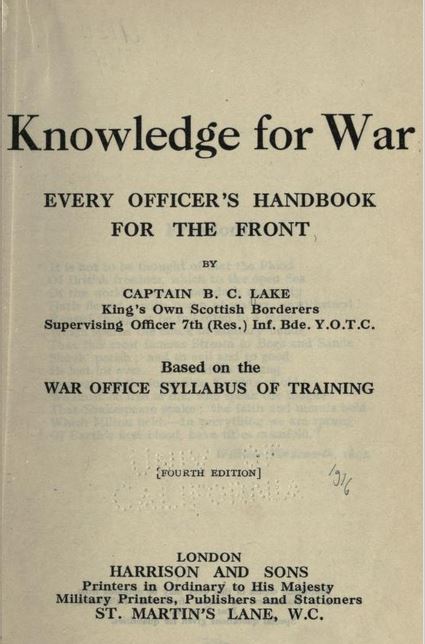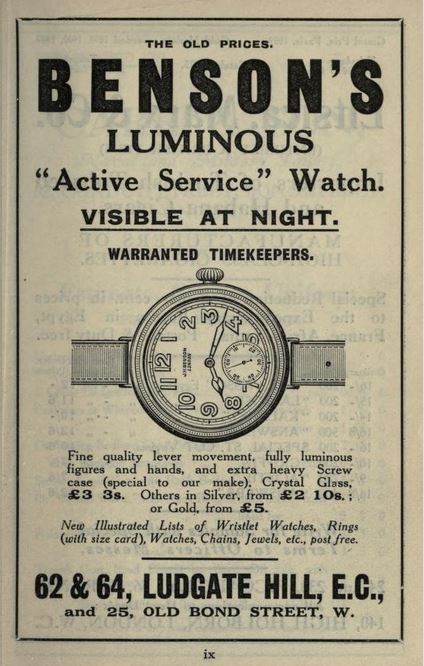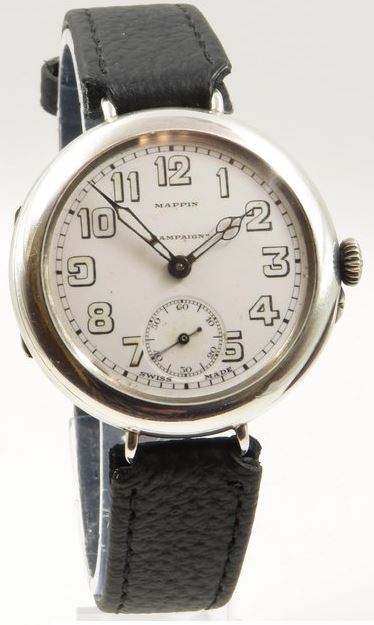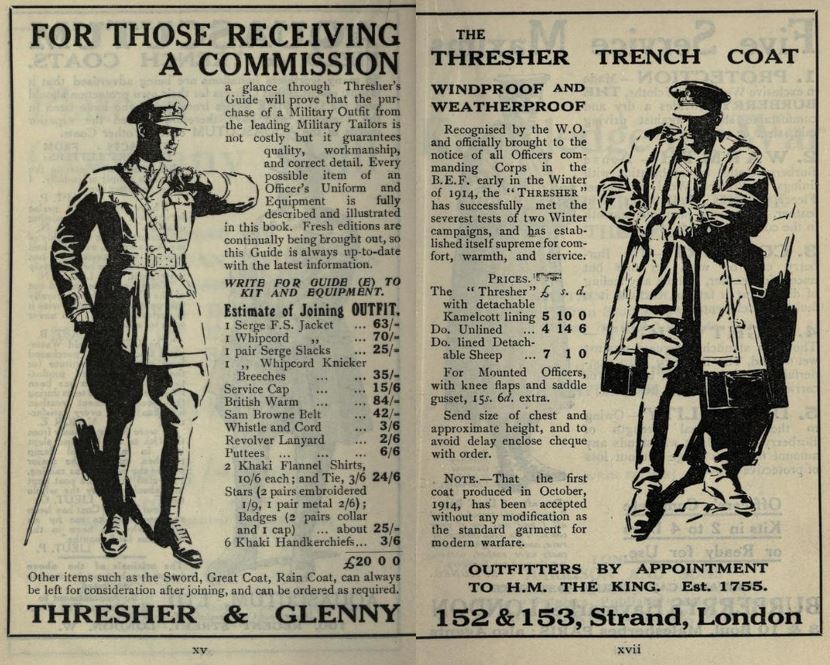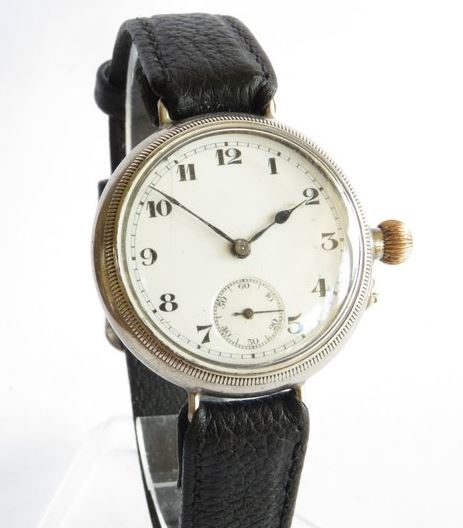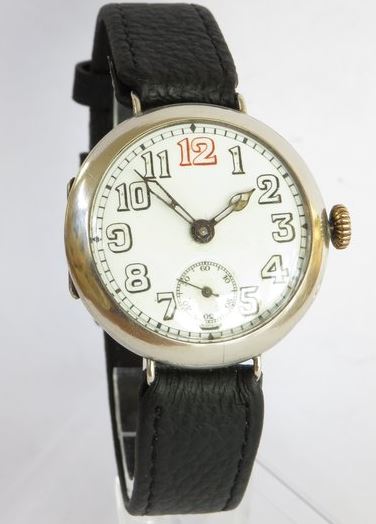Last updated on June 27, 2024
Recently I managed to stumble across an online copy of the book, Knowledge for war, every officer’s handbook for the front, by Captain B. C. Lake. It contains a significant reference to trench watches. Additionally, it has some full-page, trench watch advertisements. It is an interesting read that would have significance for military and horological historians. In this post, we will take a look at several of the advertisements from the book.
Knowledge for war, every officer’s handbook for the front
By Lake, B. C. (Basil Charles), Captain.
Publication date 1916.
Publisher London, Harrison and sons. 4th Edition, 178 pages.
The author
The author was Captain Basil Charles Lake, Commanding Officer 1st Battalion, The King’s Own Scottish Borderers at the time the book was published in 1916. In the book Captain Lake reports that he was training new officers, there is no mention of whether or not he saw active service. There is not much online regarding Captain Lake. He was born in 1889 and died in 1967. He retired from active service as a Brigadier in 1940. On the 23rd June 1921, the London Times announced the engagement of Captain Basil Charles Lake and Eileen, daughter of E. Fielding Jones of Watch Hill, Providence, USA. I could find no further information regarding his personal life.
The book
Knowledge for war, every officer’s handbook for the front work is a World War I era officer’s textbook. It contains information about military tactics, weaponry and command. The book is based on the War Office Syllabus of Training. As stated in the Introduction, Knowledge for war was not intended to be a replacement for the official syllabus and textbooks, but to be used in conjunction with them. The book includes chapters on Discipline, Drill, Musketry, Tactics and field warfare, Topography, Trench warfare, Billeting, Machine guns, Interior economy and military law, Physical drill and Signalling. The book is out of copyright but is available to read online at the Internet Archive.
My interest in the book comes from the reference to trench watches and the full-page advertising of wristwatches throughout the book. On page 177, Captain Lake has listed the recommended Officer’s kit for the Front. The very first item on the list is a “Luminous wristwatch with unbreakable glass”. This comes even before the Officer’s revolver or his field glasses. Although the officers most probably came from the upper classes, the prices of a trench watch represented about 50%+ of the average wage at the time.
Luminous wristwatches
The war in the trenches didn’t come to an end just because the sun went down and the battlefield was covered in darkness. Shelling and trench raids continued at night or at dawn when the light was poor. Frequently, these raids were synchronised and officers needed to be able to track the time in the darkness to be able to coordinate attacks. This meant that they needed to be able to read the time on their wristwatches in complete darkness. To do this they needed their trench watches to be luminous. The alternative was to light a match to read the time which could attract the attention of snipers. The solution was to apply radioactive luminous paint to the hour markers and the hands.
The watch below is a Mappin Campaign watch from the advertisement above. This particular watch is from my collection.
Unbreakable glass
Traditionally, the watch lens was made of mineral glass, which had a tendency to shatter after a hard knock. Some trench watches were protected by a shrapnel guard, which was a metal grill over the lens. However, this obscured the watch’s face and made reading the time slightly more difficult. The solution to this issue was to make the watch lens from celluloid, a thermoplastic available from the 1860s. It was much more durable than the mineral glass. However, celluloid is unstable over long periods of time, with a tendency to yellow and warp. Therefore, typically, surviving trench watches don’t retain their original unbreakable celluloid crystals and generally have a replacement acrylic crystal.
Synchronising time
Many of the actions on the battlefield were dependent on time. Barrages and advances were all timed to the second. It was important that the troops all worked from the same timestamp. There are accuracy limitations with mechanical watches, so synchronising the time on a daily basis was necessary. It didn’t really matter if the troops were working off the wrong time, just that they were all using the same wrong time. There were a number of methods that the troops used to synchronise the time. A military camp might have a central clock that the soldiers could use to synchronise their watches. Observation balloons could lower a black ball at noon, which was retrieved at 12:10. The Eiffel Tower in Paris used a similar system to verify the time at 09:00, 17:00 and 20:00.
Telegraphed timings to the various battlefield positions would be sent from regional Headquarters, typically at 09:00, 12:00, 18:00 and 23:00. An Officer would be detailed to take a synchronized watch to their regional Headquarters. They would then set their watch to the exact time down to the second. This seems to be the most likely and accurate method to distribute the time. Although, the time could be telegraphed to any unit with the relevant technology.
Borgel trench watches
The most famous trench watches were the Borgel cased watches. These had a distinctive extended pendant for the crown and were considered to be truly waterproof. There are a number of accounts of these watches being fully submerged in water and coming out functioning perfectly. I have been trying for a number of years to add one of these remarkable watches to my collection. However, it must be noted that Borgel made cases only, not complete watches.
Trench watch advertisements
The images on this page were largely trench watch advertisements taken from the Knowledge for war. For the most part, these were the retailers selling the watches, rather than the actual watchmakers. The only exception might be Benson who was still possibly manufacturing watches until the Second World War. Of the retailers, Thresher & Glenny, Goldsmiths and Mappin & Webb are still trading today. It is interesting to note that the ads refer to the watches as wristlets.
Related content
Harrison and sons, Wikipedia entry.
The Art Gallery at the Vintage Watch Room London.
